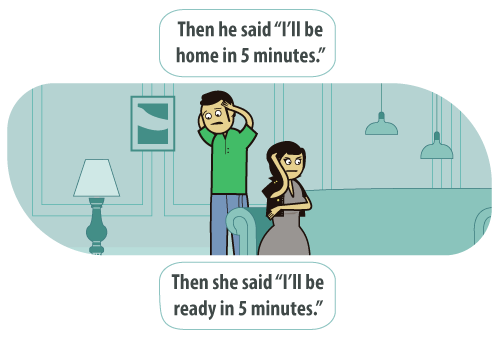
These are examples of real uses of Reported speech in everyday situations.
Through this topic, you will learn how to use reported speech in negatives sentences as well as using reporting verbs to express the ideas.
This topic is quite essential because its use is widespread in the daily use of the English Language.
Along with the topic, you will work with the four skills as follows.
So let’s start!
By the end of this topic, you will:
Be able to use Reported Speech from conversations and ideas from a third person to transmit them in its negative form.

Brian. (2014). Reinventing the Wheel: Shakespeare for Community Theaters. Tomada de: http://ticketpeak.com/blog/blog/reinventing-the-wheel-shakespeare-for-community-theatres/#sthash.RbtGugYf.dpbs
Check the following chart to get to know this critical topic.

In English, we have two ways of repeating what another person said.
When you report people’s words, you can give exact words; this is called “direct speech.”
You can also report someone’s ideas or words as part of your sentence; this is “reported speech”.

Foammi, J. (2016). Hermanas. Tomada de: https://pixabay.com/es/ni%C3%B1as-chismes-mujeres-la-moda-1733357/
We can use reported speech in a variety of situations, for example:
SAY
You use say when You don’t want to mention the person who is listening to the information.
Note:
If you want to mention the person who is listening to the information, you need to use the preposition “TO”

NA. (2015). Llamada. Tomado de: https://pixabay.com/es/hablar-tel%C3%A9fono-la-comunicaci%C3%B3n-845619/
The following common reporting verbs follow the same pattern as SAY
verb + (that) + clause
Admit
Answer
Agree
Confirm
Deny
Suggest
Mention
Insist
(ELT base, 2008-2016)

Altmann, G. (2013). Parley. Tomado de: https://pixabay.com/es/intercambio-de-ideas-debate-222788/
We use tell when we want to mention the person who is listening to the information or receiving it.
verb + direct object + (that) + clause
advise
convince
promise
warn
(ELT base, 2008-2016)
When you report it is necessary to pay attention to some aspects
| Direct speech | Reported speech | Direct speech | Indirect speech |
|---|---|---|---|
| Present Simple | Past Simple | She does laundry on Saturday. | She said she did her laundry on Saturday. |
| Present Continuous | Past Continuous | Spike is sleeping in the couch. | She said Spike was sleeping in the couch. |
| Present Perfect | Past Perfect | David has seen a psychiatrist since 1990 | She said David had seen a psychiatrist since 1990. |
| Present Perfect Continuous | Past Perfect Continuous | We have been looking for an apartment for the last four months | She said they have been looking for an apartment for the last four months. |
| Past simple | Past Simple Past Perfect |
My dog ate my homework | She said her dog ate her homework. She told me her dog had eaten her homework |
| Past Continuous | Past Continuous Past Perfect Continuous |
I was running this morning. | She said she was running this morning. She told me she had been running this morning. |
| Future “Will” | Would | You will clean up your room before playing soccer. | My mom told me I would clean-up my room before playing soccer. |
| Is/are/am going to | Was/were going to | We are going to Las Vegas next week. | They told me they were going to Las Vegas next week. |
| Can | Could | Sarah can help you. | She said Sarah could help me. |
| May | Might | I may go to a party. | She said she might go to a party. |
| Would | Would | Fany would love to win the lottery. | She said Fany would love to win the lottery. |
| Should | Should | He should tell her the truth. | She said to him He should tell the truth. |
| I | He / She | |
| We | They | |
| My | His / Her | |
| Our | Their |
Remember you have to consider logical changes. If you are reporting the information and you are the person or included in the group who did the action, you may not need to make any change.
| Now | -> | Then |
| Today | -> | That day |
| Yesterday | -> | The day before The previous day |
| Tomorrow | -> | The day after The next day |
| Next week, month, etc. | -> | The following week, month, etc. The week, month, etc. after |
| Last week, month, etc. | -> | The previous week, month, etc. The week, month, etc. before |
| This morning or afternoon | -> | That morning or afternoon |
| These days | -> | Those days |
| Here | -> | There |
When we report negative sentences it is necessary to remember they are not negatives to the person you are talking to, you are just telling that person that somebody denied something.
In these sentences you can use auxiliary verbs.
Example:
Direct: I didn’t say anything yesterday
Indirect |
The student | said | he didn’t say | anything the day before |
| Mention the person who talked | Use reporting verb | Change tense, if necessary | Change the time expression if necessary |
Direct: I didn’t say anything yesterday
Indirect: The student said he didn’t say anything the day before.
What did you say yesterday?
Direct: I don’t know what I said but I deny everything. I wasn’t thinking
Indirect: She said she didn’t know what she said but she denied everything. She said she wasn’t thinking.
Colette and Jason are a famous couple. They were so renowned in the ’80s that they were usually on the front page of magazines. Unfortunately, one morning Colette was murdered, and the prime suspect was Jason.
Colette wrote the following letter to Jason a few days before her death. You will practice your reading comprehension.
Read the letter and answer the questions, explain your answers.
Click here for the reading: A letter from Colette to Jason.
Now answer to the following questions, in the end, you will know your performance.
The next conversation took place at a psychologist practice during Jason and Colette’s session, you will practice your understanding of Reported Speech, negative sentences by reporting only 5 negative ideas from the conversation above. Before you send your activity make sure it has the following characteristics.
Jason: Hello! (1)You don’t look well.
Colette: (2) I am not feeling ok.
Jason: (3) I have not seen you like this before.
Colette: (4) I haven’t felt this broken ever.
Jason: Is there anything I can do for you? (5) I wouldn’t like to thing I am responsible of your pain.
Colette: (6) You are not.
Jason: Good. (7) I won’t say I’m perfect but I want to try.
Colette: (8)You can’t know how much I love you.
Jason: (9) No, I can’t but I will try to love you just as much.
As we mentioned before, Jason and Colette were the most famous couple in America. In the next exercise, decide if the following statements are True or False by choosing the appropriate option according to the reading. You can know your score at the end of the exercise.
You will listen to a news show commenting on Jason Thompson's case. Through this activity, you will practice your listening comprehension, and the topic reviewed along with the unit, then decide if the sentences are True (T) or False (F).
To hear the audio click here:
Along with the exercises you have noticed about the sad story of Jason and Colette. Change the following sentences from the audio into reported speech. Be careful to make the appropriate changes.
Re-tell your favourite scene from a movie or TV show. Reported Speech will help you re-tell what other people said. You do not have to use reported Speech all the way, but you have to use it when you mention their dialogues. Use between 120 – 150 words.
Look at the following example:
Please, check your activity, make sure it has the characteristics of the following checklist:
Read the letter attached below which was written by Colette Tompson to her husband to learn new vocabulary from context and drag the highlighted words or phrases to the following meanings.
Click here for the reading: A letter from Colette to Jason
Once you finished, begin your activity. Drag the different options to the appropriate spaces to complete the sentences. You have two attempts to answer the exercise. You can know your score at the end of the exercise.
Activity 7
Remember to consider all the appropriate changes. You will practice everything checked in this topic. The following are excerpts from the two 911 calls Colette Brown Thompson made to police on Oct. 25, 1993, from her townhouse.
Report what they said.
DISPATCHER: What does he look like?
COLETTE: He's Jason Thompson. You don't know that! Could you send somebody over here?
DISPATCHER: What is he doing there?
COLETTE: I don't know.
DISPATCHER: Can you wait a minute? What kind of car is he in?
COLETTE: No, I can't! He is not in a car. He's in a white Bronco.
(Jack Walraven, 1993)
Once you have finished reading the dialogue, record yourself reporting the facts.
Make sure it has the following characteristics and the aspects described in the rubric:
Listen to the following example:
In the exercise below, you will practice the changes you must do while reporting sentences.
You must drag the words in the box to the correct space to complete the text coherently. There are two extra options.
When you finish press submit to check your answers.
When I was younger, you couldn’t watch the television without catching something about Jason Thompson, who was a massive football star at the end of the ’80s, but I am not a huge fan of sports, so I am not sure, anyway.
Colette's 911 call of 1993
The following are excerpts from the two 911 calls Colette Brown Tompson made to police on Oct. 25, 1993, from her townhouse.
Report what they said.
ELT base. (2016). ELT base. Obtenido de http://www.eltbase.com/notes.php?id=59
Jack Walraven. (1993). The Simpson Trial Transcripts. Recuperado de http://simpson.walraven.org/index.html
Perfect English Grammar. (2016). Reported Speech. Taken from: http://www.perfect-english-grammar.com/reported-speech.html
English Lessons4u. (2015). Grammar: Learn to use reported speech in English. URL: https://www.youtube.com/watch?v=lcnVMh0tR9w
Teacher PhilEnglish. (2015). Changing Direct into Indirect Speech. URL: https://www.youtube.com/watch?v=ew4YHmNigRs
Lopera, A. (2015). Reported Speech explicado de forma sencilla. URL: https://www.youtube.com/watch?v=HLFqFIjelFg